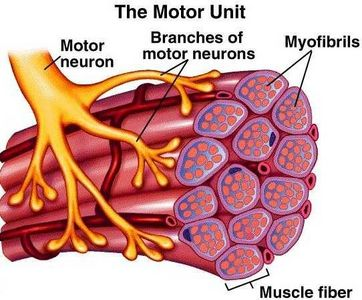Motor units and motor pools
In neuroscience, a motor pool refers to a class of motor spinal neurons which innervate the similar muscle. The biological importance of motor pool organization is in the fact that motor pools with many neurons generate finer movements. For illustration, the motor unit of muscles in the torso will control more muscle fibers and therefore cannot discriminate and selectively contract one specific fiber over the other. In fingers, the muscles will have a high amount of neurons innervating similar muscles, therefore permitting for more accurate movements.
A motor unit is a single α-motor neuron and all of the corresponding muscle fibers it innervates; all of these fibers will be of the same type (either fast twitch or slow twitch). When a motor unit is activated, all of its fibers contract. Groups of motor units often work together to coordinate the contractions of a single muscle; all of the motor units that subserve a single muscle are considered a motor unit pool. Larger motor units have stronger twitch tensions.

The number of muscle fibers within each unit can vary: thigh muscles can have a thousand fibers in each unit, eye muscles might have ten. In general, the number of muscle fibers innervated by a motor unit is a function of a muscle's need for refined motion. The smaller the motor unit, the more precise the action of the muscle. Muscles requiring more refined motion are innervated by motor units that synapse with fewer muscle fibers.Nerve cell axons are very thin, about 1 micrometer. However, they are extraordinarily long. For many motor neurons the axon is over a meter long, extending from the spinal column to a muscle cell. They stretch the spinal column to increase height.
In medical electrodiagnostic testing for a patient with weakness, careful analysis of the motor unit action potential (MUAP) size, shape, and recruitment pattern can help in distinguishing a myopathy from a neuropathy.